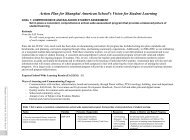Curriculum and Instruction - SAS-WASC
Curriculum and Instruction - SAS-WASC
Curriculum and Instruction - SAS-WASC
You also want an ePaper? Increase the reach of your titles
YUMPU automatically turns print PDFs into web optimized ePapers that Google loves.
• <strong>Curriculum</strong> is best designed by teachers who work together to develop <strong>and</strong>review scope <strong>and</strong> sequence <strong>and</strong> establish uniform curriculum for all subjects.• It provides the framework for what is taught, why it is taught, <strong>and</strong> how it istaught.• It must translate into student success• The design, review <strong>and</strong> revision of curriculum is an open-ended process.• <strong>Curriculum</strong> review contributes to the self renewal of the school <strong>and</strong> is itselfcyclical <strong>and</strong> recursive. It promotes professional growth <strong>and</strong> stimulateslearning.• Enables the school to be accountable for teaching what students should learn.The process of curriculum review at <strong>SAS</strong> is interactive by design <strong>and</strong> the goal isshared underst<strong>and</strong>ing of the content <strong>and</strong> method of what is taught. Though cyclicalin form, the aim is developmental in process. That development takes, in most cases,three years, though in reality, some subjects are taking longer <strong>and</strong> some not as long –again depending on the nature of the subject, the extent of the progress made towardalignment <strong>and</strong> collaboration across campuses, <strong>and</strong> the professional learning requiredto fully engage teachers in the data-gathering <strong>and</strong> analysis process of the review.Challenges for even progress in curriculum review include the number of newfaculty members that need to be brought on board in these years of growth, differentstages of development of the two campuses <strong>and</strong> the two distinct campus cultures thatprovide the context for the work.Four subject areas were in the stages of review or renewal in school year 2007-2008: PK-12 language arts, 6-12 Chinese, 6-12 mathematics, <strong>and</strong> 6-12 science.The challenge of addressing this number of areas to review was not taken lightly<strong>and</strong> an explicit decision was made to proceed based on the urgency expressed bothby teachers <strong>and</strong> the community (e.g., 6-12 Mathematics, Chinese <strong>and</strong> Science).Further, the data indicated that PK-5 language arts, literacy in particular, neededurgent attention. Elementary campuses would not be able to sustain curriculumreview in more than language arts <strong>and</strong> since the urgencies expressed for attention tomathematics, science <strong>and</strong> Chinese concerned middle <strong>and</strong> high school, the task forceswere limited in scope to these levels. Further work to articulate curriculum betweenPK-5 <strong>and</strong> 6-12 in language arts, mathematics, science <strong>and</strong> Chinese is an importantarea of attention.Two areas entered the implementation stage in 2007-2008: English as a SecondLanguage <strong>and</strong> Academic Support. Also in 2007-2008, library/media <strong>and</strong> technologyst<strong>and</strong>ards <strong>and</strong> benchmarks were reviewed <strong>and</strong> a curriculum framework for K-12technology was refined <strong>and</strong> reviewed. Reports on the program review progress ofthese areas are found in Support for Student Personal <strong>and</strong> Academic Growth chapterof this report.As an example of the process, in 2005-2006, ESOL <strong>and</strong> academic support researchedbest practices <strong>and</strong> gathered data on their programs; in 2006-2007, they pilotedplacement tools, continuing to gather <strong>and</strong> analyze data, <strong>and</strong> made recommendationsfor implementation. Recommendations were addressed by administration so thatin 2007-2008, implementation could begin. In 2007-2008, a full professionaldevelopment plan for training faculty across the campus in best-practicedelivery strategies for English language learners was designed <strong>and</strong> is poised forimplementation in 2008-2009.Documenting the <strong>Curriculum</strong>In 2005-2006, st<strong>and</strong>ards <strong>and</strong> benchmarks were set into place for all subject areas <strong>and</strong>scope <strong>and</strong> sequence of benchmarks was established in the fall of 2006. The stage wasset for the school to begin documenting its full curriculum on Atlas Rubicon.Shanghai American School Self Study Report 75



